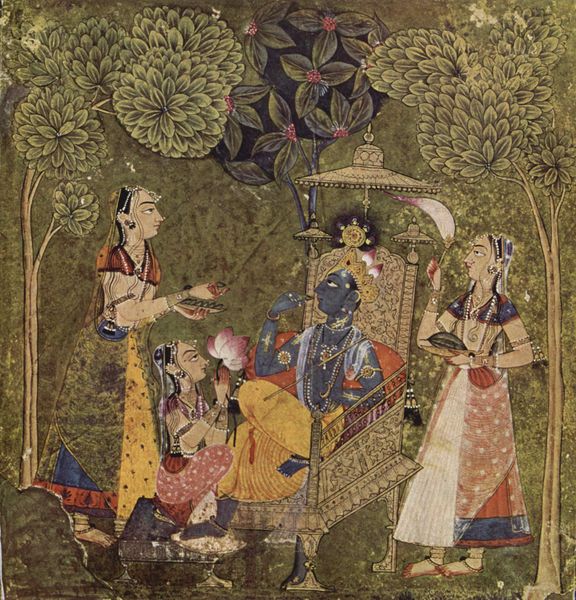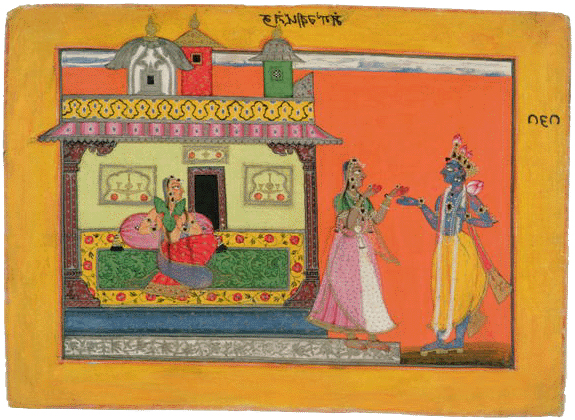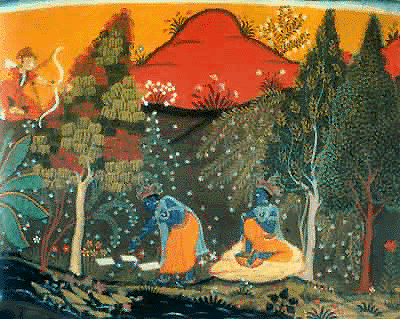The Transcendental Art of Basholi
BY: SUN STAFF

Krsna and the Gopis, Ragmala, c. 1710
Dec 02, CANADA (SUN) — From times immemorial, Jammu province was divided into small states. Lakhanpur, Jasrota, Billawar, Ramnagar, Chinani, Baderwah, Kashtwar, Kirmachi, Akhnoor, Poonch and Basohili were the independent states of Jammu province. They had to give the part of their revenue to the rulers of Delhi and Punjab. The rulers of these petty states constructed forts, palaces and temples in their domains.
From the historical point of view, Basholi ever held an important place among these autonomous petty states. The town of Basholi is situated on the northeast and is about 130 kms from Jammu proper. Basholi is famous for its distinctive Basholi School of paintings, which is known worldwide owing to their uniquely beautiful style. Basholi paintings have carved a separate place in the field of art.
Masterpieces of Basholi paintings are not only found in India but also in the museums abroad. Dogra Art Museum in Jammu has an excellent collection of Basholi paintings. The Pal rulers of Basholi were patrons of art. During their regime, Basholi paintings added new dimensions to the Pahari art, blending so many novel elements. Out of this mixture evolved the peculiar and distinctive style of painting known as Basholi.
The early Pahari paintings of the mid-17th century were in the Basholi style. They were characterised by a strong use of primary colours (red, mustard yellow and blue) and by faces with receding foreheads and great expressive eyes, shaped like lotus petals. Apart from clothing, which was typically borrowed from the Mughal paintings, the Basholi paintings had adopted individual styles and themes.
One of the most popular theme of Basholi painting was from Bhanu Datta’s Rasamanjari, which was profusely used by the renowned Basholi artist, Devi Das in 1694-1695 AD. Other favourite themes include love of Madhava-Malati, Radha-Krishna episodes and pastimes from the Bhagavata Purana.
Basholi artists also had a fondness for doing portraits of the local rajas in plain white garments, and these paintings bear a resemblance to the Rajasthani and Malwa paintings.

Krishna arriving at Radha's house, illustration from 'Rasamanjari' of Bhanudatta, c.1660-70
So many famous artists and painters hailing from different quarters of the country adorned the royal durbar of Basholi rulers. These artists received lot of patronage and encouragement by the Basholi rulers, which is indicative of their fine taste for art. Consequently the artists embellished the palace walls with their art.
Basholi palace paintings were worth seeing once. Rang Mahal of Basholi Palace has been a popular theme of discussion in the artistic circles of the country as well as abroad. Much has been written on the buildings and palaces of Basholi. Many visitors from the country and abroad visited this place. Their travel accounts facilitated our imagination in building conjectural picture of the past glory and grandeur of Basholi. Now only ruins are left to tell the story of the glorious past of Basholi.
Basholi paintings have a peculiar style and the colours used are also different. Some critics have tried to relate it with the Kangra School of paintings, while others say that the Basholi region evolved a new and individual style all its own. This style there may have some similarities with other schools as far as theme and content are concerned, but the overall style is distinctive.
In Basholi, on the bank of River Ravi there is an ancient Shiva temple. The precise date of its construction is yet to be established. Besides Shiva linga, there is a cluster of many other deities represented around the linga, viz. Nandi, Bhairava, Hanuman and Ganesha. The roof of this temple is in terrace form. Adjacent to this very temple there is also a small temple of Shiva's consort Parvati.

Krishna Preparing for Radha's Arrival, from Gita-Govinda
On the bank of River Ravi are two caves. These caves are carved out from a huge rock the big cave is having two rooms. The outer room is square and the height of the ceiling is seven and a half feet. From the ceiling is hanging a bell. The room has three niches: a niche on the western side of the cave room is bigger than the other two. On the southern sides of the cave room leads to another room. On the left side of the entrance is a life-size image of the founder of Basholi, Raja Vishva Rana.
Outside the cave is a big boulder. On the eastern side of the boulder is a niche having the height of one meter. Inside the niche is the Shiva linga. On the backside of the niche are the relief images of Shiva and Parvati. On one side of the niche is a three-headed image of Shiva. Outside, on the top of the niche, is a carved image of Ganesha, on the left side of the niche is Nandi and on the right side is Hanuman. Some of the images are defaced beyond recognition. From the iconography point of view the work is not up to the mark and does not show excellence in chiseling work, but still the work is appreciable. About one and a half kilometers from Basholi is a small hamlet of Mahadera. There also is an ancient Shiva temple.
Old monuments are an integral part of cultural heritage, which has survived down the ages. Very often, these artifacts provide signposts for the imagery and iconography found in paintings, such as the many elaborate Basholi depictions of Lord Sri Krsna.
Adapted from an article by Virendra Bangroo, IGNCA.
